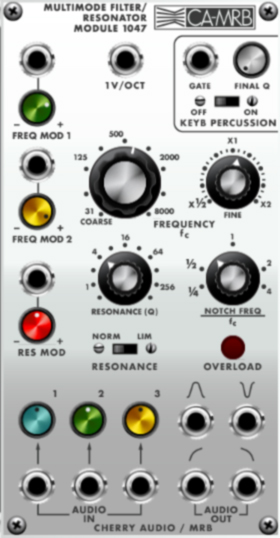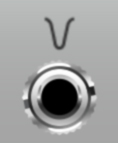
The 1047 Multimode Filter/Resonator module is a 12 dB state-variable filter. It can function as a lowpass, bandpass, highpass, or notch filter. This gives it a great deal of flexibility, and its generally a bit brighter than a typical "ladder"-style filter as a result of its shallower 12 dB/oct curve. The 1047 Filter also extremely rich-sounding overdrive characteristics when pushed hard.
If you're not familiar with how filters work, a lowpass filter allows frequencies below the cutoff frequency setting to pass through, but blocks frequencies above the cutoff frequency. Highpass is the opposite of lowpass mode: high-frequency content remains, but low frequencies are removed as the cutoff frequency increases. The bandpass output combines both lowpass and highpass modes, leaving sound only "in the middle" with amplitude falling off symmetrically on either side of the cutoff frequency. Each slope is 6db/octave. Finally, the notch output is the opposite of bandpass mode, removing a section of signal "in between" the lowpass and highpass frequencies. This isn't necessarily all that useful on its own, but makes interesting colors when its frequency is swept.
Inputs, Outputs, and Controls
1V/Oct jack- Accepts a CV input for scaling the cutoff frequency to match ascending notes. Typically this would come from the Pitch jack in the IO Panel CV Out section, or from a sequencer CV out.
Frequency fc / Coarse and Fine- Sets the frequency where frequency attenuation begins with its effect dependent upon the currently chosen lowpass/bandpass/notch/highpass/etc. filter mode. The Coarse knob affects overall cutoff frequency from 30 to 8000 Hz, and the Fine knob allows "fine-tuning" in more precise increments.
Frequency Mod 1/2 CV jacks and attenuators- These are CV input jacks and attenuators for externally controlling cutoff frequency. Both jacks can be used simultaneously. The attenuators are bipolar - center position is zero; turn right for positive CV or left for inverted (negative) CV values.
Resonance (Q)- Emphasizes sound energy at and around the cutoff frequency. This is useful for creating commonly heard synth "wah" tones, especially when the cutoff frequency is modulated with an envelope generator or one of the LFO's.
Res Mod CV jack and attenuator- CV input jack and attenuator for externally controlling filter resonance. The attenuator is bipolar - center position is zero; turn right for positive CV or left for inverted (negative) CV values.

Notch Frequency fc- Sets the frequency of the notch filter mode as a multiple of the cutoff frequency, ranging from 1/4 to four times the cutoff frequency. The Notch Freq fc knob only affects the notch output, shown above.
Pure notch response occurs when Notch Frequency fc is set to the middle position; LP or HP response is heard when the knob is moved left or right. Notch response is best heard at low resonance settings - high resonance settings "closes up" the notch, rendering it inaudible. If Notch Frequency fc is moved and resonance is audible, it's because the LP or HP outputs are coming through.
Resonance - Norm/Lim switch- Limit mode causes the filter to be unity gain at the resonant frequency. In normal mode, the filter gain at the resonant frequency is equal to Q, which on this filter can get very large - over 50dB!
To better understand the functionality of the Norm/Lim switch, turn the Coarse/Frequency fc knob all the way down and the Resonance (Q) knob all the way up. Patch in a sawtooth wave around middle C and slowly start turning the Coarse/Frequency fc knob up - you'll be able to sweep through the harmonics like a magnifying glass and the filter will never clip.
Overload lamp- This lights up when the incoming signal is too hot. Back off ye olde gain if this lights up.
Keyb Percussion- This is a unique feature of the original 2500 1047 filter. It uses a gate signal to briefly "ping" the filter for ringing sine-wave filter effects - no other oscillator or audio inputs are necessary. The Keyb Percussion function works on all four filter outputs, but the bandpass output is perhaps the most suited to this effect (the lowpass output tends to thump and the highpass tends to tick). It can be used for anything from Hammond organ-type attack transients (we suspect that was the original intention) to booming 808-style kick drums, dependent upon cutoff frequency and resonance settings. Its controls are as follow:
Gate- Patch a gate CV to this input to trigger keyboard percussion
Off/On - Enables and disables keyboard percussion.
Final Q- Sets the amount of resonant ringing after gate voltage goes to zero, i.e. on key-up. Effectively functions as a release control. Final Q can be set either higher or lower than the resonance control. This creates different effects such as choking or extended ringing after the key is released.
Final Q might also be a Star Trek: The Next Generation episode... uh... maybe not.
1/2/3 Input jacks and attenuators - Patch audio signals in here. These essentially act as an input mixer for signals. Note that the 1047 filter is really sensitive to levels - different mixes of fundamental vs. resonance, as well as overdrive levels can be achieved by adjusting input gain.
Audio Out jacks- Individual outs for bandpass, notch (top row), highpass, and lowpass (bottom row) filter outputs. Try patching all four to a mixer and using the level controls to create unique filter curves.